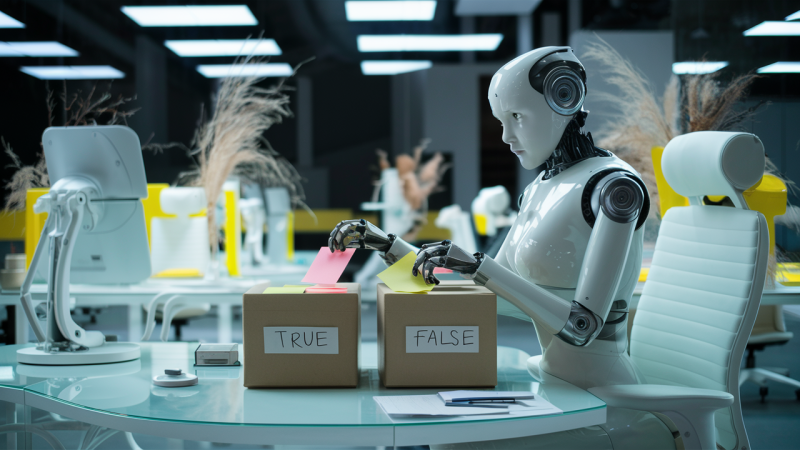We traced the sources of AI anomalies, provided practical tips on how to avoid them, and explained how fact-checking can ensure the reliability of AI results. Read on.
Fact-checking and AI hallucinations - table of contents
In the world of artificial intelligence, the lines between fiction and reality sometimes blur. While innovative AI systems are accelerating progress in almost every field, they also come with challenges, such as hallucinations – a phenomenon where AI generates inaccurate or false information. To fully harness the potential of this technology, we need to understand hallucinations and fact-checking them.
What are AI hallucinations?
AI hallucinations are false or misleading results generated by AI models. This phenomenon has its roots at the heart of machine learning – a process in which algorithms use huge data sets, or training data, to recognize patterns and generate responses according to observed patterns.
Even the most advanced AI models are not error-free. One of the causes of hallucinations is the imperfection of the training data. If the data set is insufficient, incomplete, or biased, the system learns incorrect correlations and patterns, which leads to the production of false content.
For example, imagine an AI model for facial recognition that has been trained primarily on photos of Caucasian people. In such a case, the algorithm may have trouble correctly identifying people of other ethnic groups because it has not been properly “trained” in this regard.
Another cause of hallucinations is overfitting, which occurs when the algorithm adapts too closely to the training data set. As a result, it loses the ability to generalize and correctly recognize new, previously unknown patterns. Such a model performs well on training data but fails in real, dynamic conditions.
Finally, hallucinations can result from faulty assumptions or inadequate model architecture. If the AI designers base their solution on faulty premises or use the wrong algorithmic structure, the system will generate false content in an attempt to “match” these faulty assumptions with real data.

Source: DALL·E 3, prompt: Marta M. Kania (https://www.linkedin.com/in/martamatyldakania/)
Examples of hallucinations
The impact of AI hallucinations goes far beyond the realm of theory. Increasingly, we are encountering real, sometimes surprising, manifestations of them. Here are some examples of this phenomenon:
- In May 2023, a lawyer used ChatGPT to prepare a lawsuit that included fictitious citations of court decisions and non-existent legal precedents. This led to serious consequences – the lawyer was fined, as he claimed that he knew nothing about ChatGPT’s ability to generate false information,
- it happens that ChatGPT creates false information about real people. In April 2023, the model fabricated a story about the alleged harassment of students by a law professor. In another case, it falsely accused an Australian mayor of taking bribes, when, in fact, he was a whistleblower exposing such practices.
These are not isolated cases – generative AI models often invent historical “facts,” for example, providing false records of crossing the English Channel. What’s more, they can create completely different false information on the same subject each time.
However, AI hallucinations are not just a problem of faulty data. They can also take bizarre, disturbing forms, as in the case of Bing, which declared that it was in love with journalist Kevin Roose. This shows that the effects of these anomalies can go beyond simple factual errors.
Finally, hallucinations can be deliberately induced by special attacks on AI systems, known as adversarial attacks. For example, slightly altering a photo of a cat made the image recognition system interpret it as …. “guacamole.” This type of manipulation can have serious consequences in systems where accurate image recognition is crucial, like in autonomous vehicles.
How to prevent hallucinations?
Despite the scale of the challenge posed by AI hallucinations, there are effective ways to combat the phenomenon. The key is a comprehensive approach that combines:
- high-quality training data,
- relevant prompts, i.e., commands for AI,
- directly providing knowledge and examples for AI to use,
- continuous supervision by humans and the AI itself to improve AI systems.
Prompts
One of the key tools in the fight against hallucinations are properly structured prompts, or commands and instructions given to the AI model. Often, minor changes to the prompt format are enough to greatly improve the accuracy and reliability of the generated responses.
An excellent example of this is Anthropic’s Claude 2.1. While using a long context gave 27% accuracy without a relevant command, adding the sentence “Here is the most relevant sentence from the context: ” to the prompt, increased the effectiveness to 98%.
Such a change forced the model to focus on the most relevant parts of the text, rather than generating responses based on isolated sentences that were taken out of context. This highlights the importance of properly formulated commands in improving the accuracy of AI systems.
Creating detailed, specific prompts that leave the AI as little room for interpretation as possible also helps reduce the risk of hallucinations and makes fact-checking easier. The clearer and more specific the prompt, the lower the chance of hallucination.
Examples
Besides efficient prompts, there are many other methods to reduce the risk of AI hallucinations. Here are some of the key strategies:
- using high-quality, diverse training data that reliably represents the real world and possible scenarios. The richer and more complete the data, the lower the risk of AI generating false information,
- using data templates as a guide for AI responses – defining acceptable formats, scopes, and output structures, which increases the consistency and accuracy of generated content,
- limiting sources of data to only reliable, verified materials from trusted entities. This eliminates the risk that the model will “learn” information from uncertain or false sources.
Continuous testing and refinement of AI systems, based on analyzing their actual performance and accuracy, allows for ongoing correction of any shortcomings and enables the model to learn from mistakes.
Context
Properly defining the context in which AI systems operate also plays an important role in preventing hallucinations. The purpose for which the model will be used, as well as the limitations and responsibilities of the model, should be clearly defined.
Such an approach makes it possible to set a clear framework for AI to operate within, reducing the risk of it “coming up with” unwanted information. Additional safeguards can be provided by using filtering tools and setting probability thresholds for acceptable results.
Applying these measures helps establish safe paths for AI to follow, increasing the accuracy and reliability of the content it generates for specific tasks and domains.

Source: Ideogram, prompt: Marta M. Kania (https://www.linkedin.com/in/martamatyldakania/)
Fact-checking. How to verify the results of working with AI?
Regardless of what precautions are taken, a certain amount of hallucination by AI systems is unfortunately unavoidable. Therefore, a key element that guarantees the reliability of the obtained results is fact-checking – the process of verifying facts and data generated by AI.
Reviewing AI results for accuracy and consistency with reality should be considered one of the primary safeguards against the spread of false information. Human verification helps identify and correct any hallucinations and inaccuracies that the algorithms could not detect on their own.
In practice, fact-checking should be a cyclical process, in which AI-generated content is regularly examined for errors or questionable statements. Once these are identified, it is necessary not only to correct the AI-generated statement itself, but also to update, supplement, or edit the AI model’s training data to prevent similar problems from recurring in the future.
Importantly, the verification process should not be limited to simply rejecting or approving questionable passages, but should actively involve human experts with in-depth knowledge in the field. Only they can properly assess the context, relevance, and accuracy of AI-generated statements and decide on possible corrections.
Human fact-checking thus provides a necessary and difficult-to-overestimate “safeguard” for the reliability of AI content. Until machine learning algorithms reach perfection, this tedious but crucial process must remain an integral part of working with AI solutions in any industry.
How to benefit from AI hallucinations?
While AI hallucinations are generally an undesirable phenomenon that should be minimized, they can find surprisingly interesting and valuable applications in some unique areas. Ingeniously exploiting the creative potential of hallucinations offers new and often completely unexpected perspectives.
Art and design are areas where AI hallucinations can open up entirely new creative directions. By taking advantage of the models’ tendency to generate surreal, abstract images, artists and designers can experiment with new forms of expression, blurring the lines between art and reality. They can also create unique, dreamlike worlds – previously inaccessible to human perception.
In the field of data visualization and analysis, in turn, the phenomenon of hallucination offers the opportunity to discover alternative perspectives and unexpected correlations in complex sets of information. For example, AI’s ability to spot unpredictable correlations can help improve the way financial institutions make investment decisions or manage risk.
Finally, the world of computer games and virtual entertainment can also benefit from the creative aberrations of AI. The creators of these solutions can use hallucinations to generate entirely new, captivating virtual worlds. By infusing them with an element of surprise and unpredictability, they can provide players with an incomparable, immersive experience.
Of course, any use of this “creative” side of AI hallucinations must be carefully controlled and subject to strict human supervision. Otherwise, the tendency to create fiction instead of facts can lead to dangerous or socially undesirable situations. The key, therefore, is to skillfully weigh the benefits and risks of the phenomenon, and to use it responsibly only within a safe, structured framework.
Fact-checking and AI hallucinations – summary
The emergence of the phenomenon of hallucinations in AI systems is an inevitable side effect of the revolution we are witnessing in this field. The distortions and false information generated by AI models are the flip side of their immense creativity and ability to assimilate colossal amounts of data.
For now, the only way to verify the validity of AI-generated content is through human verification. While there are several methods for reducing hallucinations, from prompting techniques to complex methods such as Truth Forest, none of them can yet provide satisfactory response accuracy that would eliminate the need for fact-checking.

If you like our content, join our busy bees community on Facebook, Twitter, LinkedIn, Instagram, YouTube, Pinterest, TikTok.
Author: Robert Whitney
JavaScript expert and instructor who coaches IT departments. His main goal is to up-level team productivity by teaching others how to effectively cooperate while coding.
AI in business:
- Threats and opportunities of AI in business (part 1)
- Threats and opportunities of AI in business (part 2)
- AI applications in business - overview
- AI-assisted text chatbots
- Business NLP today and tomorrow
- The role of AI in business decision-making
- Scheduling social media posts. How can AI help?
- Automated social media posts
- New services and products operating with AI
- What are the weaknesses of my business idea? A brainstorming session with ChatGPT
- Using ChatGPT in business
- Synthetic actors. Top 3 AI video generators
- 3 useful AI graphic design tools. Generative AI in business
- 3 awesome AI writers you must try out today
- Exploring the power of AI in music creation
- Navigating new business opportunities with ChatGPT-4
- AI tools for the manager
- 6 awesome ChatGTP plugins that will make your life easier
- 3 grafików AI. Generatywna sztuczna inteligencja dla biznesu
- What is the future of AI according to McKinsey Global Institute?
- Artificial intelligence in business - Introduction
- What is NLP, or natural language processing in business
- Automatic document processing
- Google Translate vs DeepL. 5 applications of machine translation for business
- The operation and business applications of voicebots
- Virtual assistant technology, or how to talk to AI?
- What is Business Intelligence?
- Will artificial intelligence replace business analysts?
- How can artificial intelligence help with BPM?
- AI and social media – what do they say about us?
- Artificial intelligence in content management
- Creative AI of today and tomorrow
- Multimodal AI and its applications in business
- New interactions. How is AI changing the way we operate devices?
- RPA and APIs in a digital company
- The future job market and upcoming professions
- AI in EdTech. 3 examples of companies that used the potential of artificial intelligence
- Artificial intelligence and the environment. 3 AI solutions to help you build a sustainable business
- AI content detectors. Are they worth it?
- ChatGPT vs Bard vs Bing. Which AI chatbot is leading the race?
- Is chatbot AI a competitor to Google search?
- Effective ChatGPT Prompts for HR and Recruitment
- Prompt engineering. What does a prompt engineer do?
- AI Mockup generator. Top 4 tools
- AI and what else? Top technology trends for business in 2024
- AI and business ethics. Why you should invest in ethical solutions
- Meta AI. What should you know about Facebook and Instagram's AI-supported features?
- AI regulation. What do you need to know as an entrepreneur?
- 5 new uses of AI in business
- AI products and projects - how are they different from others?
- AI-assisted process automation. Where to start?
- How do you match an AI solution to a business problem?
- AI as an expert on your team
- AI team vs. division of roles
- How to choose a career field in AI?
- Is it always worth it to add artificial intelligence to the product development process?
- AI in HR: How recruitment automation affects HR and team development
- 6 most interesting AI tools in 2023
- 6 biggest business mishaps caused by AI
- What is the company's AI maturity analysis?
- AI for B2B personalization
- ChatGPT use cases. 18 examples of how to improve your business with ChatGPT in 2024
- Microlearning. A quick way to get new skills
- The most interesting AI implementations in companies in 2024
- What do artificial intelligence specialists do?
- What challenges does the AI project bring?
- Top 8 AI tools for business in 2024
- AI in CRM. What does AI change in CRM tools?
- The UE AI Act. How does Europe regulate the use of artificial intelligence
- Sora. How will realistic videos from OpenAI change business?
- Top 7 AI website builders
- No-code tools and AI innovations
- How much does using AI increase the productivity of your team?
- How to use ChatGTP for market research?
- How to broaden the reach of your AI marketing campaign?
- "We are all developers". How can citizen developers help your company?
- AI in transportation and logistics
- What business pain points can AI fix?
- Artificial intelligence in the media
- AI in banking and finance. Stripe, Monzo, and Grab
- AI in the travel industry
- How AI is fostering the birth of new technologies
- The revolution of AI in social media
- AI in e-commerce. Overview of global leaders
- Top 4 AI image creation tools
- Top 5 AI tools for data analysis
- AI strategy in your company - how to build it?
- Best AI courses – 6 awesome recommendations
- Optimizing social media listening with AI tools
- IoT + AI, or how to reduce energy costs in a company
- AI in logistics. 5 best tools
- GPT Store – an overview of the most interesting GPTs for business
- LLM, GPT, RAG... What do AI acronyms mean?
- AI robots – the future or present of business?
- What is the cost of implementing AI in a company?
- How can AI help in a freelancer’s career?
- Automating work and increasing productivity. A guide to AI for freelancers
- AI for startups – best tools
- Building a website with AI
- OpenAI, Midjourney, Anthropic, Hugging Face. Who is who in the world of AI?
- Eleven Labs and what else? The most promising AI startups
- Synthetic data and its importance for the development of your business
- Top AI search engines. Where to look for AI tools?
- Video AI. The latest AI video generators
- AI for managers. How AI can make your job easier
- What’s new in Google Gemini? Everything you need to know
- AI in Poland. Companies, meetings, and conferences
- AI calendar. How to optimize your time in a company?
- AI and the future of work. How to prepare your business for change?
- AI voice cloning for business. How to create personalized voice messages with AI?
- Fact-checking and AI hallucinations
- AI in recruitment – developing recruitment materials step-by-step
- Midjourney v6. Innovations in AI image generation
- AI in SMEs. How can SMEs compete with giants using AI?
- How is AI changing influencer marketing?
- Is AI really a threat to developers? Devin and Microsoft AutoDev
- AI chatbots for e-commerce. Case studies
- Best AI chatbots for ecommerce. Platforms
- How to stay on top of what's going on in the AI world?
- Taming AI. How to take the first steps to apply AI in your business?
- Perplexity, Bing Copilot, or You.com? Comparing AI search engines
- ReALM. A groundbreaking language model from Apple?
- AI experts in Poland
- Google Genie — a generative AI model that creates fully interactive worlds from images
- Automation or augmentation? Two approaches to AI in a company
- LLMOps, or how to effectively manage language models in an organization
- AI video generation. New horizons in video content production for businesses
- Best AI transcription tools. How to transform long recordings into concise summaries?
- Sentiment analysis with AI. How does it help drive change in business?
- The role of AI in content moderation


















